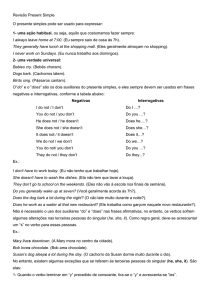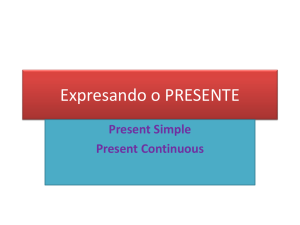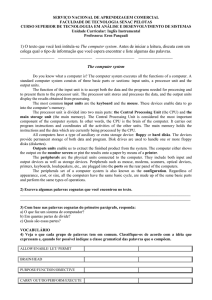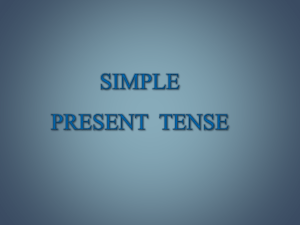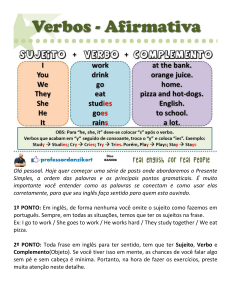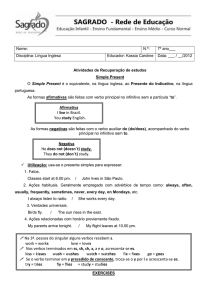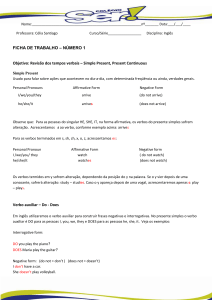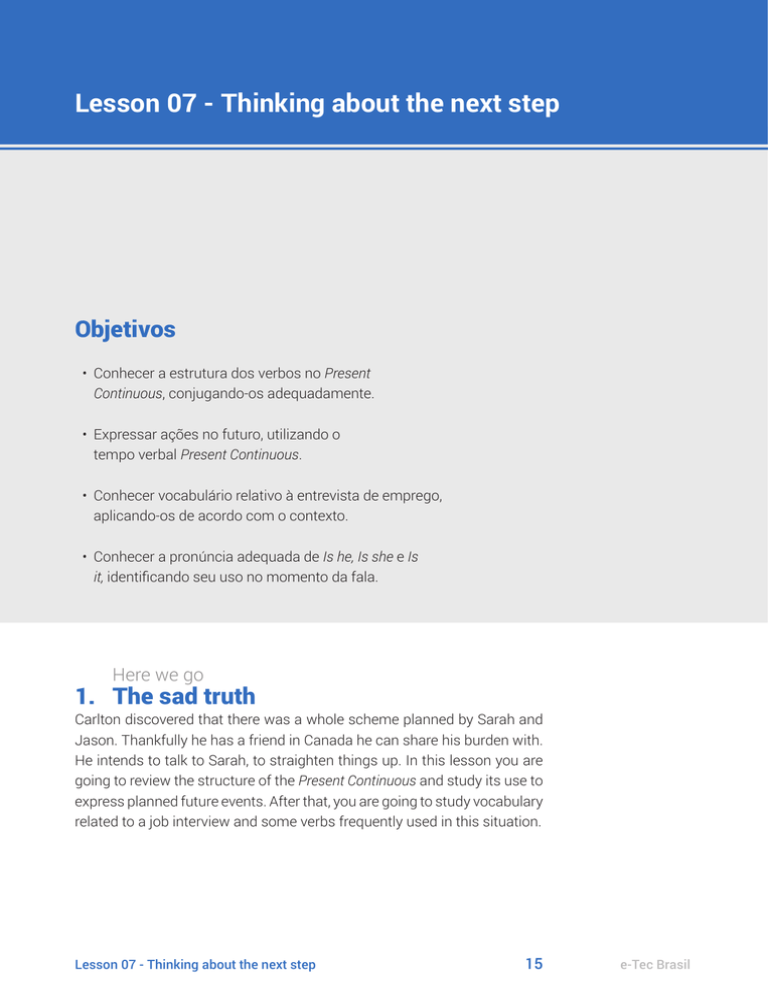
Lesson 07 - Thinking about the next step
Objetivos
• Conhecer a estrutura dos verbos no Present
Continuous, conjugando-os adequadamente.
• Expressar ações no futuro, utilizando o
tempo verbal Present Continuous.
• Conhecer vocabulário relativo à entrevista de emprego,
aplicando-os de acordo com o contexto.
• Conhecer a pronúncia adequada de Is he, Is she e Is
it, identificando seu uso no momento da fala.
Here we go
1. The sad truth
Carlton discovered that there was a whole scheme planned by Sarah and
Jason. Thankfully he has a friend in Canada he can share his burden with.
He intends to talk to Sarah, to straighten things up. In this lesson you are
going to review the structure of the Present Continuous and study its use to
express planned future events. After that, you are going to study vocabulary
related to a job interview and some verbs frequently used in this situation.
Lesson 07 - Thinking about the next step
15
e-Tec Brasil
In the Out loud section you are going to study the pronunciation of the verb
Is with the subjects he, she and it in Yes-no questions and interrogative
sentences starting with a question word.
Warming up
2. What is Carlton doing next?
Carlton meets the beggar and now he knows the truth about the fake funeral
and the people involved. He is sitting with Bruno, and while they have a
beer he tells his friend everything. Listen and read to their conversation:
Carlton: ... and then the funeral was over. After that, I signed some papers and left.
The next day, I discovered that everything was a lie. The person in the coffin was
actually a beggar, can you believe it? Poor guy, they took advantage of him.
Integrated media
Acesse a mídia Finding out the
truth e acompanhe a conversa
entre Carlton e Bruno.
Bruno: Gee, that’s crazy! And did you find out what really happened to your father?
Carlton: Not yet... That’s what worries me the most. I hope he is OK.
Bruno: Me too, man. And what about those papers you signed?
Carlton: I don’t know, I just signed them. The girl said it was to allow the cremation.
It was another lie, obviously.
Bruno: What are you gonna do now? Call the police?
Glossary
Beggar: a person who lives
on the streets and begs
for money and food
To allow: to give someone
permission to do something
To run out (of): to finish or
use so there is nothing left
Carlton: Not yet. First I wanna talk to her, I know where she works. Tomorrow I'll
catch her by surprise. She won't be able to escape. I wanna know about my father
and this whole scheme.
Bruno: Do you want me to go with you?
Carlton: Thanks, Bruno. I’d rather do it on my own. You are helping me a lot, letting
me stay here for a few days. I’m running out of money and I have no idea what’s
coming next.
Bruno: Be cool, man. You can stay as long as you need.
e-Tec Brasil
16
English
In this conversation, Carlton and Bruno used Going to and Will to talk about
the future, to express what Carlton intends to do. Besides these two verb
tenses, we can also use the Present Continuous to talk about the future. In the
next topic you are going to review the structure of the Present Continuous.
Audio
3. Getting the hang of it
3.1 Present Continuous - Structure
O Present Continuous, estudado na Lesson 09 do Módulo 01, expressa
ações em andamento no momento presente. Nesta aula, você verá que ele
também é utilizado para nos referirmos ao futuro. Ele é bem semelhante
ao Going to, mas com algumas particularidades.
Primeiro, relembre que as frases afirmativas são formadas utilizando o
presente do Verb To Be e o verbo principal na forma gerúndio (-ing):
SUBJECT
VERB TO BE
MAIN VERB + ING
COMPLEMENT
I
am
running out of
money.
You
are
helping
me a lot.
staying
in Bruno’s apartment.
lying
to her friends.
It
raining
a lot.
We
working
very hard.
studying
for the final exams.
having
a beer.
He
is
She
are
You
They
É possível fazer a contração do sujeito com o verbo To Be. Neste caso, as
frases da tabela anterior ficariam assim:
I am running out of money.
I’m running out of money.
You are helping me a lot.
You’re helping me a lot.
He is staying in Bruno’s apartment.
He’s staying in Bruno’s apartment.
She is lying to her friends.
She’s lying to her friends.
It is raining a lot.
It’s raining a lot.
Lesson 07 - Thinking about the next step
17
e-Tec Brasil
Audio
We are working very hard.
We’re working very hard.
You are studying for the final exams.
You’re studying for the final exams.
They are having some beer.
They’re having some beer.
Para colocar o verbo principal na forma gerúndio, acrescenta-se o
sufixo -ing. Para muitos verbos, não há mudança na forma base. Veja
alguns exemplos:
go
going
help
helping
rain
raining
Quando o verbo terminar em e (não pronunciado), a letra e será suprimida
para então acrescentarmos a terminação -ing:
Mind the gap
Existem algumas exceções
para essa regra, são elas:
see - seeing
pee - peeing
have
having
hope
hoping
invite
inviting
Quando o verbo for monossílabo e terminar na sequência CVC (ConsoanteVogal-Consoante), a última consoante será duplicada para então
acrescentarmos a terminação -ing.
run - running
cvc
e-Tec Brasil
18
let
letting
shop
shopping
English
Quando o verbo tiver duas sílabas e a última sílaba for tônica e
terminando em CVC, a última consoante também será duplicada antes de
acrescentarmos a terminação -ing:
Audio
begin - beginning
cvc
admit
admitting
Quando o verbo terminar em -ie, estas letras serão substituídas por y antes
de acrescentarmos a terminação -ing:
die
dying
lie
lying
Alguns verbos terminados em e ou y, ou monossílabos, fogem a estas
regras e não são acrescidos de -ing. Por serem considerados verbos
“especiais”, não são utilizados na forma de gerúndio:
VERBOS QUE INDICAM ESTADO MENTAL OU EMOCIONAL
believe
doubt
enjoy
imagine
hate
know
like
love
prefer
remember
want
satisfy
VERBOS QUE INDICAM POSSE
belong
own
owe
possess
VERBOS RELACIONADOS A SENTIDOS
appear
hear
look
see
smell
taste
feel
seem
VERBOS QUE INDICAM REAÇÕES
agree
deny
disagree
promise
satisfy
surprise
realize
understand
Lesson 07 - Thinking about the next step
19
e-Tec Brasil
OUTROS VERBOS
consist
depend
deserve
fit
need
matter
concern
be
Audio
As frases negativas são formadas acrescentando-se a partícula not ao
verbo To Be:
SUBJECT
VERB TO BE + NOT
MAIN VERB + ING
COMPLEMENT
I
am not
running out of
money.
You
are not
helping
me a lot.
staying
in Bruno’s apartment.
He
She
is not
lying.
It
raining.
We
working
very hard.
studying
for the final exams.
having
a beer.
You
are not
They
Perceba que podemos fazer a contração do verbo To Be com a partícula
not, com exceção de frases onde o sujeito é I. Desta forma, as frases da
tabela anterior ficariam assim:
e-Tec Brasil
I am not running out of money.
I’m not running out of money.
You are not helping me a lot.
You aren’t helping me a lot.
He is not staying in Bruno’s apartment.
He isn't staying in Bruno’s apartment.
She is not lying to her friends.
She isn't lying to her friends.
It is not raining a lot.
It isn't raining a lot.
We are not working very hard.
We aren’t working very hard.
You are not studying for
the final exams.
You aren’t studying for the final exams.
They are not having a beer.
They aren’t having a beer.
20
English
As yes-no questions são formadas a partir da inversão sujeito - verb To Be.
Já as short answers utilizam apenas o verbo To Be na forma afirmativa e
na forma negativa acrescenta-se o not (de forma abreviada) ao verbo.Veja:
Yes-no questions
Affirmative
short answers
Negative
short answers
Am I running out of money?
Yes, you are.
No, you aren’t.
Are you helping me a lot?
Yes, I am.
No, I’m not.
Is he staying in Bruno’s
apartment?
Yes, he is.
No, he isn’t.
Is she lying to her friends?
Yes, she is.
No, she isn’t.
Is it raining a lot?
Yes, it is.
No, it isn’t.
Are we working very hard?
Yes, you are.
No, you aren’t.
Are you studying for
the final exams?
Yes, we are.
No we aren’t.
Are they having a beer?
Yes, they are.
No, they aren’t.
Audio
Já para formar as wh-questions, basta incluir o pronome interrogativo no
início da pergunta:
What are you doing?
Where are you staying?
Why is she lying?
Após relembrar a estrutura do Present Continuous, pratique este conteúdo
com as atividades What’s going on? e Regan on the phone.
No tópico a seguir você estudará o uso do Present Continuous para
expressar futuro.
Lesson 07 - Thinking about the next step
21
Learning activity
What’s going on?
Regan on the phone
e-Tec Brasil
3.2 Present Continuous - Future
Audio
Para expressar o Future Simple em inglês, podemos utilizar Going to e Will,
conforme já visto na Lesson 01 deste módulo. Veja que no diálogo entre
Bruno e Carlton, o universitário pergunta ao amigo:
What are you gonna do now? Call the police?
Mind the gap
Veja a seguir algumas Time
expressions que você poderá
utilizar associado aos verbos
no Present Continuous.
Tomorrow
Next week
In an hour
Soon
In the near future
Eventually; finally
Later this evening.
Agora, você verá que o Present Continuous, além de expressar ações em
andamento no momento da fala, também refere-se a um futuro planejado.
O exemplo anterior poderia ser feito utilizando o Present Continuous, sem
perder o sentido de futuro planejado:
What are you doing now? Call the police?
O Present Continuous, nesse caso, expressa futuro. Seu uso é mais comum
com verbos de movimento e com Time expressions:
I’m driving to school tomorrow.
Are you coming to visit us next weekend?
He isn’t playing tennis with us on Saturday.
e-Tec Brasil
22
English
Utilizamos o Present Continuous principalmente para nos referirmos a
preparativos e planos fixos. O futuro com Going to também expressa esta
ideia, mas com mais ênfase na intenção. Veja os exemplos:
Present Continuous
Going to
I’m buying a house.
I’m going to buy a house.
Existe a pretensão de
comprar uma casa.
Já está decidido e planejado. Nesta
frase, o foco está no planejamento.
What are you doing tonight?
Are you going to do anything about
the legal documents you received?
Pergunta sobre o planejamento.
Pergunta sobre a intenção.
I’m seeing my dermatologist tomorrow.
I’m going to ask her to help me.
Ênfase no planejamento.
Ênfase na intenção.
Audio
Ainda que o Present Continuous e o Going to sejam semelhantes, para
descrever eventos que fogem ao nosso planejamento (como variações
climáticas ou alterações no preço de produtos) utiliza-se o Going to.
Observe os exemplos da tabela:
Going to
Present Continuous
According to the weather forecast,
it is going to rain later today.
It is raining.
Prices are going to rise
before the holidays.
Prices are rising every week
after the last economic crisis.
Estudar o Present Continuous lhe auxiliará nos momentos em que precisar
referir-se a eventos futuros. Verifique sua compreensão deste conteúdo
realizando as atividades Future forms in daily life and Present Continuous.
No próximo tópico você estudará o vocabulário relacionado à entrevista
de emprego.
Lesson 07 - Thinking about the next step
23
Learning activity
Future forms in daily life
Present Continuous
e-Tec Brasil
What´s the buzz
3.3 Job interview
Audio
Mr. Tennant recebe a ligação de uma candidata à vaga de garçonete,
que tem sua entrevista agendada para o dia seguinte. Veja a conversa
entre eles:
Joshua: Joshua Tennant speaking!
Amy: Good morning! I saw the ad about a vacancy for a waitress... are you
still hiring?
Integrated media
Acesse a mídia Setting a Job
interview e acompanhe Joshua
marcando uma entrevista.
Joshua: Yes, we are. What’s your name?
Amy: Amy Tyler.
Joshua: One minute, please. Late again, Sarah.
Sarah: I’m very sorry Mr. Tennant. It won’t happen again.
Joshua: Go, customers are waiting.
Joshua: So, Ms. Tyler, I’ll schedule your interview for tomorrow at 6:00 PM. Is
Glossary
Vacancy: a job that is
free for someone
To schedule: to plan a
date for an event
that OK?
Amy: No problem, Mr. Tennant. Thank you.
Joshua: OK, don’t forget to bring your résumé. Have a nice day!
Nesta conversa, Mr. Tennant e Amy utilizam palavras relacionadas à
entrevista de emprego. Quando você apply for a job, ou seja, candidatase a um emprego, é importante estar familiarizado com o vocabulário.
Acompanhe outras palavras a seguir:
CANDIDATE
e-Tec Brasil
24
A person who is applying for a job
or elected to a position.
English
SELECTION PROCESS
The act of choosing the employee(s)
out of a big group of candidates.
RÉSUMÉ
A brief written account of one’s personal,
educational and professional experience,
prepared by the applicant.
INTERVIEW
A formal meeting at which a person who is
applying for a job is asked questions to check
whether he/she would be suitable for the job.
EMPLOYEE
The person who works at a certain place.
EMPLOYER
The person who is responsible for the workers,
pays their salary and manages their activities.
HUMAN RESOURCES
DEPARTMENT (H.R.)
The department of a business
organization responsible for hiring,
firing and training the employees.
JOB APPLICATION
A formal document the applicant must
fill in, to inform the employer his personal
information and availability.
Audio
Além desse vocabulário, alguns verbos são frequentemente relacionados
a esta situação. Observe:
TO SET AN APPOINTMENT
To arrange a time to meet a professional.
If you want to talk to Mr. Tennant in the evening, you have to set an appointment.
TO APPLY FOR
To officially ask for something.
Amy wants to apply for the job as a waitress.
TO GO THROUGH A
SELECTION PROCESS
To follow the required steps in order to get a job.
I went through a selection process, but unfortunately they chose another candidate.
TO HAVE AN
APPOINTMENT
To have a day and time to meet a professional.
I have an appointment with Dr. Schwartz tomorrow. It’s about my training program.
Lesson 07 - Thinking about the next step
25
e-Tec Brasil
TO BE SELECTED/
APPROVED
To be chosen to work for someone.
I’m so happy I was selected for the job.
Audio
TO PRESENT
To orally share your ideas, so other people
can be involved in the project.
I need to present a slide show to my co-workers next week.
Learning activity
Setting a job interview
A partir do estudo deste vocabulário é possível que você consiga se
comunicar em uma situação de entrevista. Para verificar sua compreensão
acerca deste conteúdo, pratique-o realizando a atividade Setting a job
interview. No tópico a seguir você estudará a pronúncia de Is he...?, Is she...?
e Is it...?
Out loud
3.4 Is he…?, Is she…? e Is it…?
Em frases interrogativas que iniciam com Is he...?, Is she...? ou Is it...?, que
são comuns ao Present Continuous, é possível fazer a ligação entre o verbo
auxiliar e o pronome. Escute uma pergunta pronunciada de forma lenta e
pouco natural:
Is he staying in Bruno’s apartment?
Esta não é a velocidade normal de fala, pois a tendência é juntarmos sons
que se assemelham ou eliminar letras que não são pronunciadas. Neste
caso, Is e he são pronunciados como se fossem uma única palavra. A letra
s em Is adquire som de “z”, e a letra “h” de he é eliminada. Escute:
Is he?
Is he?
Escute novamente a frase completa, desta vez com as palavras Is he
pronunciadas como se fossem apenas uma, ou seja, encadeadas:
Is he staying in Bruno’s apartment?
e-Tec Brasil
26
English
O mesmo acontece se após o verbo Is tivermos o pronome it. Escute a
pergunta de forma pausada:
Audio
Is it raining a lot?
Produzindo a ligação do verbo Is com o pronome it, temos o s do verbo
adquirindo som de “z”. Escute:
Is it?
Is it?
Escute a frase completa, com as palavras Is e It pronunciadas de
forma encadeada:
Is it raining a lot?
Is it raining a lot?
Escute uma frase com o pronome she, também pronunciada de forma
lenta e pouco natural:
Is she lying to her friends?
Podemos juntar o verbo Is com o pronome she, e neste caso a letra “s” em
Is é eliminada na fala. Escute:
Is she?
Is she?
Escute agora a frase completa, e perceba como as palavras Is e she são
pronunciadas como se fossem apenas uma:
Mind the gap
Is she lying to her friends?
A pronúncia de Is he, Is she ou
Is it também vale em perguntas
que iniciam com pronomes
interrogativos ou no Present
Simple do Verbo To be.
Is she lying to her friends?
Lesson 07 - Thinking about the next step
27
e-Tec Brasil
Além de uma pronúncia correta das palavras, para uma fala fluente
é importante que você pronuncie as palavras em sequência e não
separadamente. Pronunciar palavras de forma encadeada frequentemente
resulta em uma melhor compreensão auditiva, pois torna-se mais fácil a
identificação de sons que somos capazes de produzir.
Catching a glimpse
4. Get ready for a job interview
JOSHUA
Integrated media
Acesse a mídia Get ready for a job
interview e acompanhe o texto.
e-Tec Brasil
When we apply for a job, there are some aspects to take into consideration.
You may be getting ready for your very first interview after the selection
process, or you may be an experienced professional searching for a better
opportunity. Either way, candidates should pay attention to these dos and
dont’s during a job interview:
•
When you arrive, greet the members of the staff
and the interviewer with courtesy. You have only
one chance to make a good first impression!
•
Make sure you know how to get to the interview, and arrive
at least ten minutes before your appointment. If anything
happens and you are running late, do phone the company.
28
English
• Bring your résumé, and some extra copies if possible. If you
have a portfolio, bring samples of your former productions.
• Your résumé itself will not make them hire you. No matter
how experienced and qualified you are for the position, you
will need to show the interviewer your best features.
• When asked questions, always answer truthfully,
never lie. Do not include irrelevant information. When
asked about former jobs, emphasize the positive
characteristics of your colleagues and employers.
• Stress your achievements, but do not congratulate
yourself. Show that you know how to work in group, and
no success comes from individual performance.
• Last, but not least, show your interviewer that you
have enough information about the company, and that
you are interested in contributing to the work.
5. That’s a wrap!
In this lesson you reviewed the structure of the Present Continuous, and
studied that it is also used to express a planned future. Although the
Present Continuous and Going to may be interchangeable, you cannot use
the Present Continuous to describe events like weather changes or price
increase. Besides that, you studied vocabulary related to a job interview
and some verbs frequently associated with this situation. In the Out loud
section you studied the pronunciation of Is he…?, Is she…? and Is it…?, for
interrogative sentences in the Present Continuous, as if they were only one
word in interrogative sentences.
Hope you started off with the right foot. Keep yourself motivated and move
on to Lesson 8!
Lesson 07 - Thinking about the next step
29
e-Tec Brasil
e-Tec Brasil
30
English
Lesson 07 - Thinking about the next step
31
e-Tec Brasil

